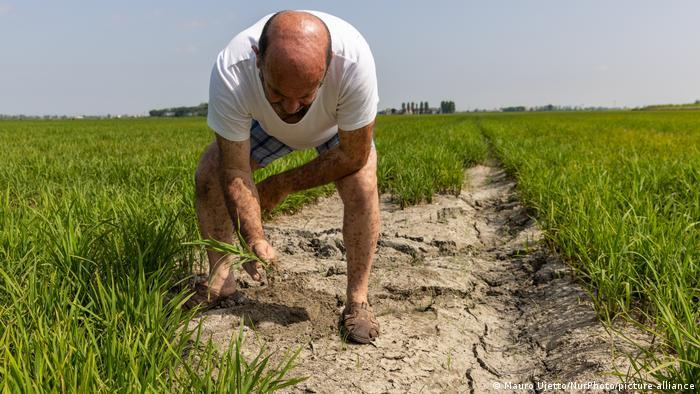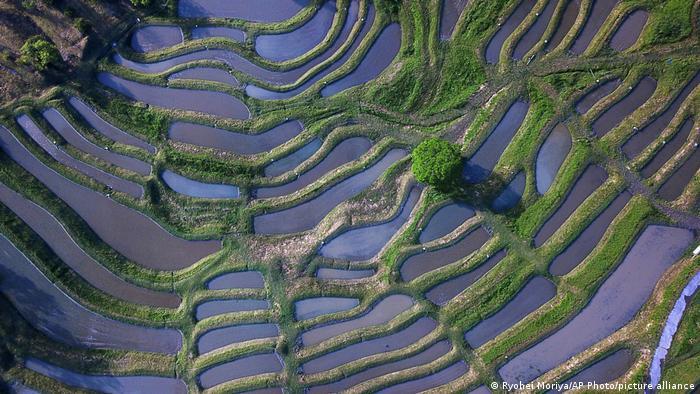How to Protect Soil From Future Drought and Heat Waves

An inch of nutrient-rich topsoil can take hundreds of years to develop.
Soil is easy to overlook as the dirt on our shoes, the realm of gardeners and farmers and nothing much to do with anyone else. But it is, of course, vital to our survival. As without soil, growing food becomes a problem.
A mixture of mineral and organic waste that teems with minute life, soil is complex matter. An inch of nutrient-rich topsoil, so integral to productive agricultural land, can take hundreds of years to develop. But it takes far less time to become dried out and potentially eroded as a result of drought — such as the one that has held Europe in its grip this summer.
"What we are seeing is that now droughts are becoming so intense, and the soil erosion is also becoming more intense," said Lizeth Vasconez Navas, a researcher at the University of Hamburg's Institute of Soil Science.
While it might be counterintuitive after months of little rain, a heavy downpour is not necessarily a blessing for farmers. Certain soils, especially those containing clay, can become so dry that they are no longer able to effectively absorb water, so when the rains do fall, the water ends up flowing over the soil, washing away tons of earth and valuable nutrients, and potentially leading to flash flooding.
In this experiment Dr Rob Thompson of @UniRdg_Met shows just how long it takes water to soak into parched ground, illustrating why heavy rainfall after a #drought can be dangerous and might lead to flashfloods. @R0b1et @UniRdg_water pic.twitter.com/zbb3xLTXdK
— Uni of Reading (@UniofReading) August 10, 2022
Nicole Wellbrock, a soil expert from the Thünen Institute for Forest Ecosystems, northeast of Berlin says climate change has made sudden, extreme rain showers more common and the right sort of precipitation rarer. "We would actually need long, steady rainfall, which seeps in slowly and moistens the soil."
So how can soil be protected?
To prevent dried out soils from being lost to erosion, experts say it's crucial to establish new ground cover as quickly as possible.
Quick-growing plants can help prevent further soil loss while helping to replenish lost nutrients by fixing nitrogen in the soil.
These "cover crops" such as legumes, wheat, oat and barley can act as sort of a natural shield, slowing evaporation and retaining moisture while reducing temperature at ground level.

Hot and dry conditions have taken their toll on Europe's farms this summer
They can replenish the health of the soil over time by controlling erosion, suppressing weeds and pests, stabilizing root systems and increasing organic matter, according to a 2021 report from The Council on Energy, Environment and Water, an Indian nonprofit research institution.
Another way of retaining soil moisture is by applying a layer of mulch — ideally in the form of a plant-based green waste compost — to its surface, said Lynda Deeks, senior research fellow in soil science at Cranfield University in the UK. "Over time it will actually be incorporated into the soil and so increase organic matter."
Biological activity in the earth lessens in extreme heat
Soil moisture is also important for the underground animal kingdom.
"When it gets so dry and so hot, microorganisms stop their activity," said Nicole Wellbrock, a soil expert from the Thünen Institute for Forest Ecosystems, northeast of Berlin. Without the input of organisms like the nematode, for example, she said the nutrient cycling system — which gives plants what they need to grow — slows.

Extreme temperatures can bring life underground to a halt
And it's not just microscopic life. "When it becomes dry, earthworms naturally go into a state called estivation — they effectively go to sleep," said Roy Nielsen, a soil ecologist based at the James Hutton Institute in Dundee, Scotland. Earthworms then stop adding organic matter and aerating the soil which also reduces the capacity for water drainage.
Bringing trees back to farmland
Vasconez Navas of the University of Hamburg says we should "look back at nature" to help ecosystems and soils to regenerate after long periods of stress. One nature-inspired solution is agroforestry, which sees trees planted among traditional cropland.
Wellbrock of the Thünen Institute said trees generally don't coexist with farmers' fields in places like Germany. "In the past, they were actually removed as part of the agricultural reforms, because of course that was arable land, and [farmers] favored large, uniform areas," she said.

Farmers in Tanzania and Kenya are finding success with low-tech solutions
Trees don't only help control erosion and evaporation and create shade, they can also help revitalize drought-damaged soils.
Certain tree species, known as fertilizer trees, take nitrogen from the air and deposit it in the soil through their roots and falling leaves. This helps farmers improve soil fertility with a low-cost alternative to industrial fertilizers. In Malawi, Zambia, Burkina Faso and other countries in sub-Saharan Africa, these trees are helping to double or triple the yields of maize, a key food staple.
Low-tech solutions and inspiration from ancient civilizations
In rural areas of Tanzania and Kenya, village communities are using a low-tech method to fight desertification.
Their technique involves digging semicircular depressions, known as "bunds," into the ground which collect water when it rains, preventing it from evaporating quickly from the scorched soil. Grass seeds are then sown into these bunds which, as they germinate, limit soil erosion and lower the ground temperature.

Terraced agriculture is making a comback in Japan and Italy
A growing, global community of conservationists are looking to the past for solutions by restoring terraces among neglected farmlands. Terraces date back to the Bronze Age and can be found in sites such as Machu Picchu in Peru. Their successive sloped planes — resembling steps cut into the earth — limit soil erosion by preventing runoff. This form of agriculture, which failed to compete large-scale cultivation during the 20th century, is now making a comeback in places like Italy and Japan.
While a range of options exist for helping to ensure soil productivity, the variety of ecosystems, soil composition and range of conditions means there's no panacea for optimal soil health. Particularly in the face of climate change.
That said, one of the best strategies for ensuring soil can deal with weather extremes is to aim for minimum disturbance, said UK expert Deeks. Organisms in the earth help create pathways that glue earth together while opening pore spaces for water and air, key for ensuring it can absorb rain. "The less we do to the soil, the better," she said.
Edited by:Tamsin Walker
Get the latest reports & analysis with people's perspective on Protests, movements & deep analytical videos, discussions of the current affairs in your Telegram app. Subscribe to NewsClick's Telegram channel & get Real-Time updates on stories, as they get published on our website.
























